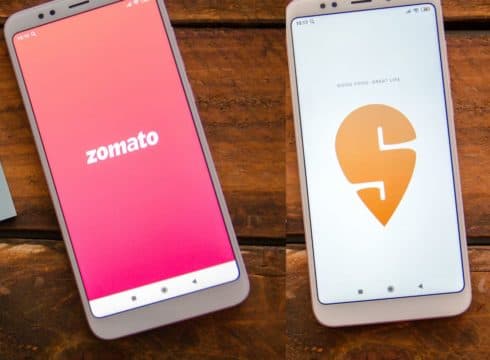In November, Zomato was reported to have 1.25 Mn daily orders
At the same time, Swiggy was said to have 1.4 Mn daily orders
Swiggy’s advertising cost was 36% less when compared to Zomato for FY19
Inc42 Daily Brief
Stay Ahead With Daily News & Analysis on India’s Tech & Startup Economy
India’s foodtech market was expected to grow to $5 Bn in 2019, and by 2023, it is expected to cross $15 Bn. While the industry has expanded across several verticals in these past few years, namely B2B, B2C, cloud kitchens, ready-to-eat etc, the food delivery space is dominated by two players — Zomato and Swiggy— as other players pivot (Foodpanda to Ola Foods) or look for exit (UberEats).
However, a common factor, beyond the cash burn of these two leading companies is their increasingly-diversified product portfolio. Right now, both Swiggy and Zomato have split their eggs into multiple baskets in an attempt to generate profits. Profitability would be no mean feat if it happens.
Comparing daily order numbers, in November, Zomato reported having 1.25 Mn daily orders, while Swiggy said it has 1.4 Mn daily orders. Further, the report added that cash burn was $20 Mn a month for Zomato and $35 Mn a month for Swiggy.
Recently, Swiggy and Zomato reported their financial performance for FY19 and continued their tryst with the losses. On a standalone basis, Zomato reported total revenue of INR 1350.47 Cr and expenses of INR 3109 Cr leading to losses of INR 1758.5 Cr for the financial year ending March 31, 2019. However, when it comes down to net loss, it was INR 570.52 Cr, as the company had gain of INR 1188 Cr, helped by the sale of their UAE business.
Swiggy Or Zomato: Who’s Winning The Race?
At the same time, Swiggy reported total revenue of INR 1292 Cr with total expense of INR 3637.6 Cr and thus, losses of INR 2345.6 Cr during the same period.
If we look at this holistically, it is clear that Swiggy is burning more cash than Zomato.
Bringing this into context again, five-year-old Swiggy has close to 160K restaurant partners across more than 500 Indian cities with a delivery fleet of 2.3 Lakh. With over a decade of being launched, Zomato is present in 500 Indian cities with over 600K partner restaurants in India and a delivery fleet of around 2.3 Lakh as well.
Hence, we took a closer look at what these companies are spending on. For instance, in What The Financials analysis of Zomato we noted that Zomato had said that it has reduced its loss per delivery by 43% in the last one year. While it lost INR 44 per delivery in March 2018, it now loses INR 25 per delivery.
At the same time, the company’s last-mile cost per delivery is now INR 65, compared to INR 86 in March 2018. One of the bigger achievements for the company, however, is that its number of deliveries per rider per hour has gone up to 1.4 from 0.9 last year.
Zomato has been under scrutiny for multiple rounds of layoffs recently. It had outsourced its customer support services and has made it more AI-based. However, even then the company’s employee benefit costs increased to INR 408.89 Cr in FY19.
In comparison, Swiggy’s employee benefits cost increased 1.88X reaching INR 537.2 Cr in FY19.
On a standalone basis, Zomato increased its advertising promotional expenses 14.16X reaching INR 1213.6 Cr in FY19. Notably, this makes up to 39% of the company’s total expenses for the year.
In comparison, Swiggy’s advertising cost was INR 776.2 Cr. This is 36% less when compared to Zomato.
Further, Swiggy claims to have achieved a dominant position in the food delivery segment by recording a 4.2 times increase in order volumes and 2.7x increase in its operating revenues “despite a higher baseline” in FY19.
Focus Beyond Food Delivery?
Swiggy is now planning to generate 30% of its overall revenue from beyond its food delivery service in the coming years as it cuts down on its losses. The company’s cofounder Sriharsha Majeti reportedly said that its food delivery business will pick up the pace, but the company also wants to diverge into other segments.
Zomato and Swiggy’s rapid popularity across consumers and restaurants boils down to a single factor — convenience. People are time-poor. Food delivery apps allow them to order food from across cuisines, track orders and pay seamlessly.
However, how long can the companies suffer the cost of convenience with investor money? While Swiggy has become a unicorn faster than Zomato, the company’s loss cycle is larger than Zomato, which is now focusing on profitability.
Update: December 24, 2019 | 5: 35 PM
The story has been updated to clarify about the net loss of Zomato, which has been positively impacted buy the sale of its UAE business.
{{#name}}{{name}}{{/name}}{{^name}}-{{/name}}
{{#description}}{{description}}...{{/description}}{{^description}}-{{/description}}
Note: We at Inc42 take our ethics very seriously. More information about it can be found here.


